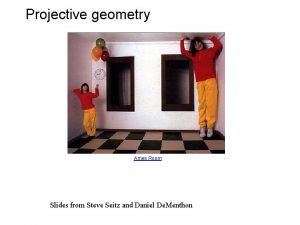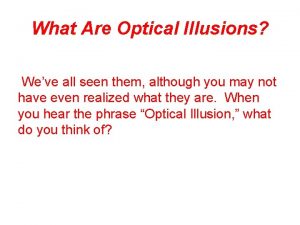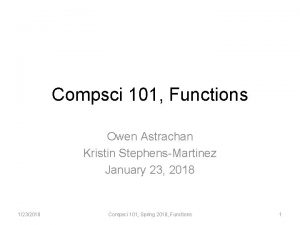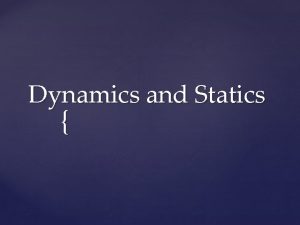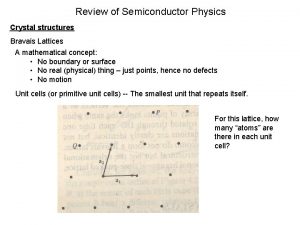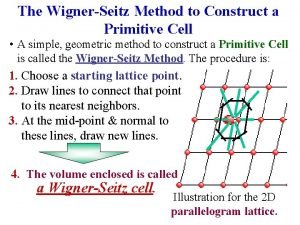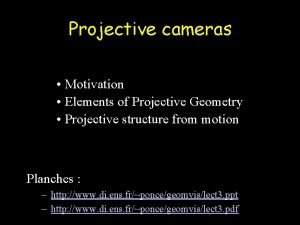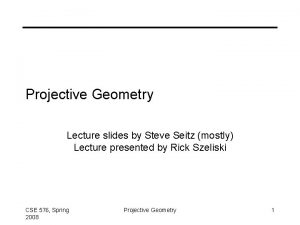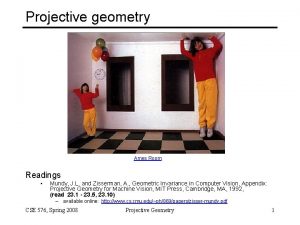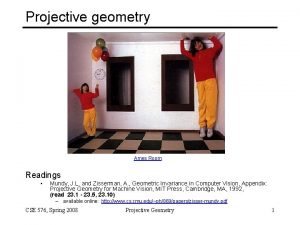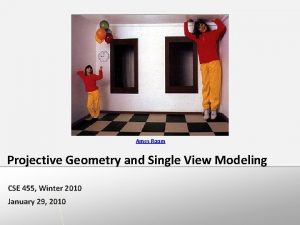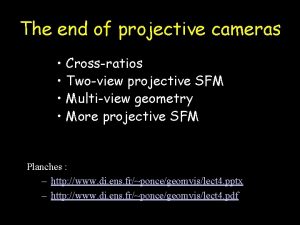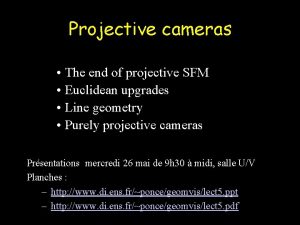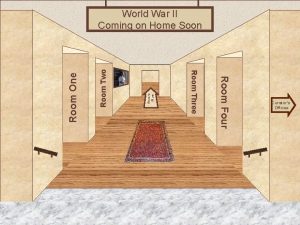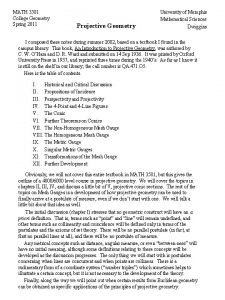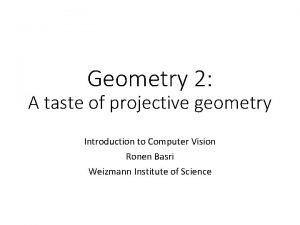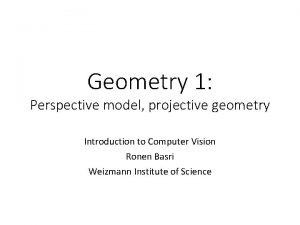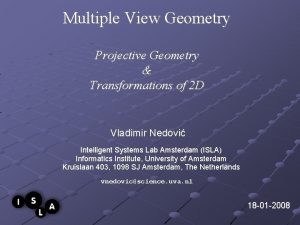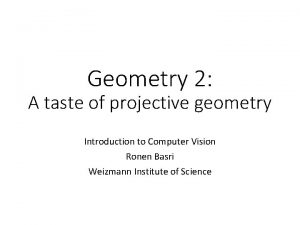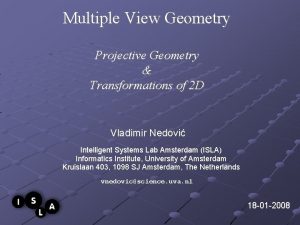Projective geometry Ames Room Slides from Steve Seitz











































- Slides: 43

Projective geometry Ames Room Slides from Steve Seitz and Daniel De. Menthon

Projective geometry—what’s it good for? Uses of projective geometry • • Drawing Measurements Mathematics for projection Undistorting images Focus of expansion Camera pose estimation, match move Object recognition


Applications of projective geometry Vermeer’s Music Lesson

Measurements on planes 4 3 2 1 1 2 Approach: unwarp then measure What kind of warp is this? 3 4

Image rectification p’ p To unwarp (rectify) an image • solve for homography H given p and p’ • solve equations of the form: wp’ = Hp – linear in unknowns: w and coefficients of H – H is defined up to an arbitrary scale factor – how many points are necessary to solve for H?

Solving for homographies

Solving for homographies A 2 n × 9 h 9 0 2 n Linear least squares • Since h is only defined up to scale, solve for unit vector ĥ • Minimize • Solution: ĥ = eigenvector of ATA with smallest eigenvalue • Works with 4 or more points

The projective plane Why do we need homogeneous coordinates? • represent points at infinity, homographies, perspective projection, multi-view relationships What is the geometric intuition? • a point in the image is a ray in projective space y (x, y, 1) (0, 0, 0) z x (sx, sy, s) image plane • Each point (x, y) on the plane is represented by a ray (sx, sy, s) – all points on the ray are equivalent: (x, y, 1) (sx, sy, s)

Projective lines What does a line in the image correspond to in projective space? • A line is a plane of rays through origin – all rays (x, y, z) satisfying: ax + by + cz = 0 l p • A line is also represented as a homogeneous 3 -vector l

Point and line duality • A line l is a homogeneous 3 -vector • It is to every point (ray) p on the line: l p=0 l p 1 p 2 l 1 p l 2 What is the line l spanned by rays p 1 and p 2 ? • l is to p 1 and p 2 l = p 1 p 2 • l is the plane normal What is the intersection of two lines l 1 and l 2 ? • p is to l 1 and l 2 p = l 1 l 2 Points and lines are dual in projective space • given any formula, can switch the meanings of points and lines to get another formula

Ideal points and lines (a, b, 0) y y (sx, sy, 0) z x image plane Ideal point (“point at infinity”) • p (x, y, 0) – parallel to image plane • It has infinite image coordinates Ideal line • l (a, b, 0) – parallel to image plane • Corresponds to a line in the image (finite coordinates)

Homographies of points and lines Computed by 3 x 3 matrix multiplication • To transform a point: p’ = Hp • To transform a line: lp=0 l’p’=0 – 0 = lp = l. H-1 Hp = l. H-1 p’ l’ = l. H-1 – lines are transformed by postmultiplication of H-1





3 D to 2 D: “perspective” projection Matrix Projection: What is not preserved under perspective projection? What IS preserved?

Vanishing points image plane vanishing point camera center ground plane Vanishing point • projection of a point at infinity

Vanishing points (2 D) image plane vanishing point camera center line on ground plane

Vanishing points image plane vanishing point V camera center C line on ground plane Properties • Any two parallel lines have the same vanishing point v • The ray from C through v is parallel to the lines • An image may have more than one vanishing point

Vanishing lines v 1 v 2 Multiple Vanishing Points • Any set of parallel lines on the plane define a vanishing point • The union of all of these vanishing points is the horizon line – also called vanishing line • Note that different planes define different vanishing lines

Vanishing lines Multiple Vanishing Points • Any set of parallel lines on the plane define a vanishing point • The union of all of these vanishing points is the horizon line – also called vanishing line • Note that different planes define different vanishing lines

Computing vanishing points V P 0 D Properties • P is a point at infinity, v is its projection • They depend only on line direction • Parallel lines P 0 + t. D, P 1 + t. D intersect at P

Computing vanishing lines C l ground plane Properties • l is intersection of horizontal plane through C with image plane • Compute l from two sets of parallel lines on ground plane • All points at same height as C project to l – points higher than C project above l • Provides way of comparing height of objects in the scene


Fun with vanishing points

Perspective cues

Perspective cues

Perspective cues

Comparing heights Vanishing Point

Measuring height 5 4 3 2 1 5. 4 Camera height 3. 3 2. 8

Computing vanishing points (from lines) v q 2 q 1 p 2 p 1 Intersect p 1 q 1 with p 2 q 2 Least squares version • Better to use more than two lines and compute the “closest” point of intersection

Measuring height without a ruler C Y ground plane Compute Y from image measurements • Need more than vanishing points to do this




The cross ratio A Projective Invariant • Something that does not change under projective transformations (including perspective projection) The cross-ratio of 4 collinear points P 3 P 1 P 4 P 2 Can permute the point ordering • 4! = 24 different orders (but only 6 distinct values) This is the fundamental invariant of projective geometry

Measuring height scene cross ratio T (top of object) R (reference point) t C v. Z r b H R B image cross ratio (bottom of object) ground plane scene points represented as image points as

Measuring height vz r vanishing line (horizon) vx t 0 t v H R H b 0 b image cross ratio vy

Measuring height vanishing line (horizon) vz r t 0 vx vy v m 0 t 1 b 0 b What if the point on the ground plane b 0 is not known? • Here the guy is standing on the box, height of box is known • Use one side of the box to help find b 0 as shown above

3 D projective geometry These concepts generalize naturally to 3 D • Homogeneous coordinates – Projective 3 D points have four coords: P = (X, Y, Z, W) • Duality – A plane N is also represented by a 4 -vector – Points and planes are dual in 3 D: N P=0 • Projective transformations – Represented by 4 x 4 matrices T: P’ = TP, N’ = N T-1

 Ames room geometry
Ames room geometry Steve seitz uw
Steve seitz uw Ba-room ba-room ba-room baripity
Ba-room ba-room ba-room baripity Ames room construction
Ames room construction Which line is longer illusion
Which line is longer illusion Absolute conic
Absolute conic Ronald wayne biography
Ronald wayne biography Splat google slides
Splat google slides A small child slides down the four frictionless slides
A small child slides down the four frictionless slides Energy of four forces quick check
Energy of four forces quick check Owl slides into room
Owl slides into room There is a living room a bedroom and a kitchen in my house
There is a living room a bedroom and a kitchen in my house Doris lessing to room nineteen
Doris lessing to room nineteen Hotel database sql queries
Hotel database sql queries Lewis structure for pf3
Lewis structure for pf3 Electron domain geometry vs molecular geometry
Electron domain geometry vs molecular geometry Covalent bond order
Covalent bond order Habia una vez un rey
Habia una vez un rey Viens esprit de dieu fait nous sentir ta presence
Viens esprit de dieu fait nous sentir ta presence Brule en nos ames flammes sacrees
Brule en nos ames flammes sacrees Kristin stephens-martinez
Kristin stephens-martinez Alicia ames
Alicia ames Ames thyroid
Ames thyroid Winfield united ames iowa
Winfield united ames iowa Ames test
Ames test Test di ames spiegazione
Test di ames spiegazione Aldrich ames
Aldrich ames Recepteur enzymatique
Recepteur enzymatique Protein synthesis
Protein synthesis Mr ames is dragging a box
Mr ames is dragging a box Dean de cock
Dean de cock Porter lee ames
Porter lee ames Cyrus trask
Cyrus trask Liza hamilton east of eden
Liza hamilton east of eden Ames test
Ames test Test d'ames
Test d'ames Seitz middle school
Seitz middle school Fcc wigner seitz cell
Fcc wigner seitz cell Brandon seitz
Brandon seitz Frank seitz teacher
Frank seitz teacher Seitz filter funnel
Seitz filter funnel Wigner-seitz primitive cell
Wigner-seitz primitive cell Yvonne seitz
Yvonne seitz Bcc mřížka
Bcc mřížka
